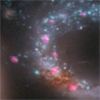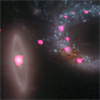CXC Home | Search | Help | Image Use Policy | Latest Images | Privacy | Accessibility | Glossary | Q&A
Tour of Arp 147
Quicktime MPEG
Just in time for Valentine's Day comes a new image of a ring -- not of jewels -- but of black holes. This image shows Arp 147, a pair of interacting galaxies some 430 million light years from Earth, as seen by the Chandra X-ray Observatory and the Hubble Space Telescope. The ring-shaped object on the right is a remnant of a spiral galaxy that collided with the elliptical galaxy to the left millions of years ago. The collision triggered a wave of star formation. Many of these new young stars raced through their evolution in a few million years or less and ended up as supernova explosions or black holes. X-rays from Chandra now reveal a ring of these black holes in the outer arms of the spiral structure. Researchers estimate that the nine sources around the ring are likely 10 to 20 times more massive than the Sun a rather impressive weight for any Valentines gift.
[Runtime: 00:59]
Quicktime MPEG
Just in time for Valentine's Day comes a new image of a ring -- not of jewels -- but of black holes. This image shows Arp 147, a pair of interacting galaxies some 430 million light years from Earth, as seen by the Chandra X-ray Observatory and the Hubble Space Telescope. The ring-shaped object on the right is a remnant of a spiral galaxy that collided with the elliptical galaxy to the left millions of years ago. The collision triggered a wave of star formation. Many of these new young stars raced through their evolution in a few million years or less and ended up as supernova explosions or black holes. X-rays from Chandra now reveal a ring of these black holes in the outer arms of the spiral structure. Researchers estimate that the nine sources around the ring are likely 10 to 20 times more massive than the Sun a rather impressive weight for any Valentines gift.
[Runtime: 00:59]
(Credit: X-ray: NASA/CXC/MIT/S.Rappaport et al, Optical: NASA/STScI)
Giant Ring of Black Holes
Quicktime MPEG
This image shows Arp 147, a pair of interacting galaxies some 430 million light years from Earth, as seen by the Chandra X-ray Observatory and the Hubble Space Telescope. The ring-shaped object on the right is a remnant of a spiral galaxy that collided with the elliptical galaxy to the left millions of years ago. The collision triggered a wave of star formation. Many of these new young stars raced through their evolution - in a few million years or less - and ended up as supernova explosions or black holes. X-rays from Chandra now reveal a ring of these black holes in the outer arms of the spiral structure. Researchers estimate that the nine sources around the ring are likely 10 to 20 times more massive than the Sun - a rather impressive weight for any Valentine's gift.
[Runtime: 00:20]
Quicktime MPEG
This image shows Arp 147, a pair of interacting galaxies some 430 million light years from Earth, as seen by the Chandra X-ray Observatory and the Hubble Space Telescope. The ring-shaped object on the right is a remnant of a spiral galaxy that collided with the elliptical galaxy to the left millions of years ago. The collision triggered a wave of star formation. Many of these new young stars raced through their evolution - in a few million years or less - and ended up as supernova explosions or black holes. X-rays from Chandra now reveal a ring of these black holes in the outer arms of the spiral structure. Researchers estimate that the nine sources around the ring are likely 10 to 20 times more massive than the Sun - a rather impressive weight for any Valentine's gift.
[Runtime: 00:20]
(Credit: X-ray: NASA/CXC/MIT/S.Rappaport et al, Optical: NASA/STScI)
Return to Arp 147 (February 9, 2011)




